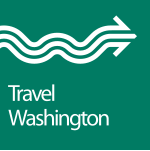
Greyhound Lines, Inc. (Greyhound) operates the largest intercity bus service in North America. Services include Greyhound Mexico, charter bus services, and Amtrak Thruway services. Greyhound operates 1,700 coach buses produced mainly by Motor Coach Industries and Prevost serving 230 stations and 1,700 destinations. The company's first route began in Hibbing, Minnesota in 1914 and the company adopted the Greyhound name in 1929. The company is owned by Flix North America, Inc., an affiliate of Flixbus, and is based in Downtown Dallas.

The Amtrak Cascades is a passenger train corridor in the Pacific Northwest, operated by Amtrak in partnership with the U.S. states of Washington and Oregon. It is named after the Cascade mountain range that the route parallels. The 467-mile (752 km) corridor runs from Vancouver, British Columbia, through Seattle, Washington and Portland, Oregon to Eugene, Oregon.
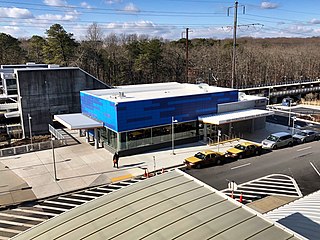
BWI Airport Station is an intermodal passenger station in Linthicum, Maryland near Baltimore–Washington International Airport (BWI). It is served by Amtrak Northeast Corridor intercity trains, MARC Penn Line regional rail trains, and several local bus lines.
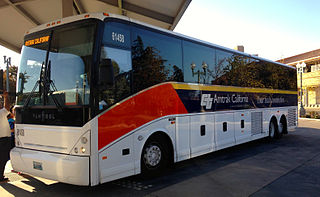
Amtrak Thruway is a system of through-ticketed transportation services to connect passengers with areas not served by Amtrak trains. In most cases these are dedicated motorcoach routes, but can also be non-dedicated intercity bus services, transit buses, vans, taxis, ferry boats and commuter rail trains.

Transportation in Philadelphia involves the various modes of transport within the city and its required infrastructure. In addition to facilitating intracity travel, Philadelphia's transportation system connects Philadelphia to towns of its metropolitan area and surrounding areas within the Northeast megalopolis.
The Washington State Department of Transportation is a governmental agency that constructs, maintains, and regulates the use of transportation infrastructure in the U.S. state of Washington. Established in 1905, it is led by a secretary and overseen by the governor. WSDOT is responsible for more than 20,000 lane-miles of roadway, nearly 3,000 vehicular bridges and 524 other structures. This infrastructure includes rail lines, state highways, state ferries and state airports.

Springfield Union Station is a train and bus station in the Metro Center area of Springfield, Massachusetts. Constructed in 1926, Springfield Union Station is the fifth-busiest Amtrak station in the Commonwealth, and the busiest outside of Greater Boston.

The Charlottesville Union Station, located in Charlottesville, Virginia, United States, is served by Amtrak's Cardinal,Crescent, and daily Northeast Regional passenger trains. It is Amtrak's third-busiest station in Virginia, aside from its all-auto Auto Train station in Lorton. The station is situated in the northeast quadrant of the junction between two railway lines. The Cardinal uses the east–west line, owned by the state of Virginia, and formerly by CSX Transportation, and operated by the Buckingham Branch Railroad, while other services use the north–south line owned and operated by Norfolk Southern Railway. The station is within walking distance of the University of Virginia, which is the major employer in the area.

Everett Station is an Amtrak train station serving the city of Everett, Washington. The station has provided service to the Cascades and Empire Builder routes since its opening in 2002, replacing an earlier station near the Port of Everett. The four-story building also houses social service programs and is the center of a 10-acre (4 ha) complex that includes parking lots and a large bus station used primarily by Community Transit, Everett Transit, and Sound Transit Express. The station has served as the northern terminus of the Sounder N Line since 2003 and the Swift Blue Line since 2009. It consists of two side platforms, one serving Amtrak and the other serving Sounder commuter trains. Everett Station also functions as a park and ride, with 1,067 short-term parking spaces located in lots around the station after it was expanded by Sound Transit in 2009.
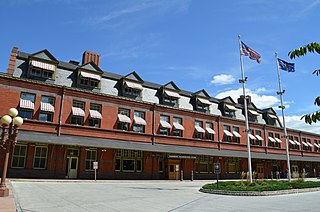
The Harrisburg Transportation Center is a railway station and transportation hub in Harrisburg, Pennsylvania. It is located on the eastern edge of Downtown Harrisburg between the intersections of Aberdeen and Market Streets and 4th and Chestnut Streets.

Sacramento Valley Station is an Amtrak railway station in the city of Sacramento, California, at 401 I Street on the corner of Fifth Street. It is the seventh busiest Amtrak station in the country, and the second busiest in the Western United States with thousands of riders a day and over a million passengers per year. Today, it is served by 38 daily Amtrak and Amtrak California trains and many Amtrak Thruway Motorcoaches. It is also the western terminus of the Sacramento RT Gold Line light rail system and the Route 30 bus serving Sacramento State University.
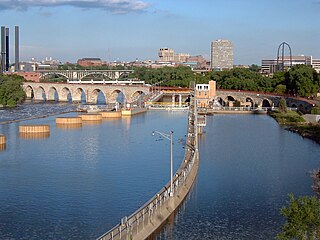
Transportation in the U.S. State of Minnesota consists of a complex network of roadways, railways, waterways and airports. The transportation system is generally overseen by the Minnesota Department of Transportation, a cabinet-level agency of the state government. Additionally, regional governments such as the Metropolitan Council have authority over regional planning for the transportation system and local governments such as cities and counties oversee the local transportation network.

Milwaukee Intermodal Station is the main intercity bus and train station in Milwaukee, Wisconsin, located downtown. The station is served by Amtrak's Empire Builder and Hiawatha Service as well as bus companies Coach USA - Wisconsin Coach Lines, Greyhound Lines, Jefferson Lines, Indian Trails, Lamers, Badger Bus, Tornado Bus Company, and Megabus.

Tacoma Dome Station is a train station and transit hub in Tacoma, Washington, United States. It is served by Amtrak trains, the S Line of Sounder commuter rail, the T Line of Link light rail, and buses on local and intercity routes. Located near the Tacoma Dome south of Downtown Tacoma, the station consists of two train platforms used by Sounder and Amtrak trains, a platform for the T Line, a bus terminal, and two parking garages. The Sounder station is integrated into Freighthouse Square, a former Milwaukee Road depot that was converted into a shopping mall, and is on the east side of the Amtrak station.
The city of Williamsburg, Virginia has a full range of transport facilities. Williamsburg is served by the Newport News/Williamsburg International Airport, and by two larger but more distant airports. The city is linked to several Interstate and State highways. A transport hub - the Williamsburg Transportation Center - serves bus and rail passengers. Motor traffic is restricted in the historic area, and the city as a whole is more "walkable" than the US norm. Cycling routes are also being provided.

Redding station is an intercity train station served by Amtrak's Coast Starlight, located in Redding, California, United States. The depot was built by the Southern Pacific Railroad in 1923 and opened on February 5, 1924. The train station has sheltered waiting areas on both platforms and a parking lot near the southbound platform.
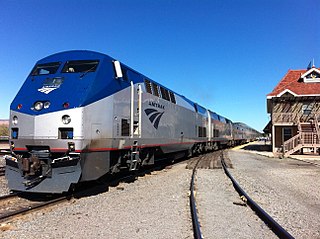
Public transportation in the United States refers to publicly financed mass transit services across the nation. This includes various forms of bus, rail, ferry, and sometimes, airline services. Most established public transit systems are located in central, urban areas where there is enough density and public demand to require public transportation. In more auto-centric suburban localities, public transit is normally, but not always, less frequent and less common. Most public transit services in the United States are either national, regional/commuter, or local, depending on the type of service. Furthermore, sometimes "public transportation" in the United States is an umbrella term used synonymously with "alternative transportation", meaning any form of mobility that excludes driving alone by automobile. This can sometimes include carpooling, vanpooling, on-demand mobility, infrastructure that is fixated toward bicycles, and paratransit service.

The South Bend Public Transportation Corporation is a municipal bus system that serves the cities of South Bend and Mishawaka, as well as the nearby suburbs of Notre Dame and Roseland, in the very north of the U.S. state of Indiana. It is the most recent incarnation of the South Bend Railway Company, a street railway company that was founded on May 25, 1885. Transpo receives funding from local, state and federal taxes. In 2021, the system had a ridership of 987,900, or about 4,500 per weekday as of the third quarter of 2022.
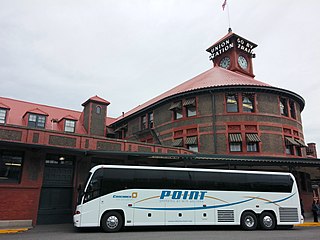
The POINT Intercity Bus Service is a four-route, intercity bus service of the Oregon Department of Transportation (ODOT). The service is administered by ODOT's Public Transportation Division as part of its intercity grant program. The POINT service exists to connect towns and rural communities with major transportation hubs and urban centers. ODOT accomplishes this by filling gaps in Oregon's long distance transit network where no public services exist and which would otherwise be unprofitable for private companies.
